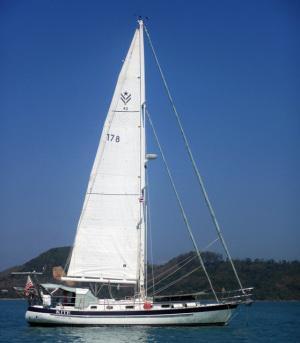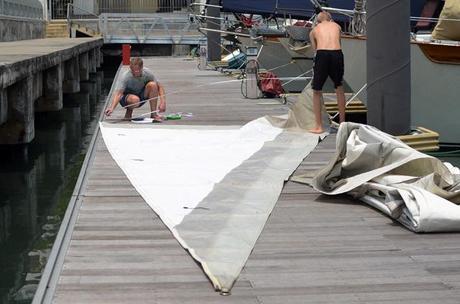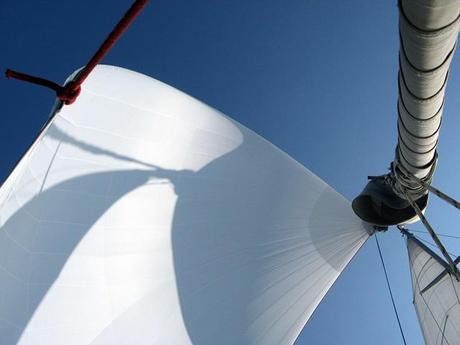
A dependable suit of sails to carry you towards the horizon is the basic tool of every cruiser. I’m sharing more of Jamie’s expertise as a sailmaker on the blog: most recently, about how to check the stitching in sails for UV damage. This time- he’s going to tell you how to evaluate the cloth.
Jamie often checks sails on the boats we’re with. The cruising boats we meet in Southeast Asia have often done hard miles, but you don’t have to cross an ocean to have sailcloth damaged by UV exposure. He’d like to empower sailors with the right information to check their own to avoid an unpleasant days on the water, or worse.
Sailmaker says
Testing sailcloth for UV damage is not as obvious as the thread test, but should give you a good idea of condition before running off to a sail loft.

Kite’s main looks great at a distance, but inspection showed a few problems: UV and hinge points were factors.
Torn cloth
Sails tear for a variety of reasons, and any tear is a perfect opportunity to test for UV damage. Simply, tear at the existing damage (just a little!). Easily torn cloth is likely rotten. If it tears, but not so easily, then it may have some damage. Of course, 5 ounce cloth is delicate compared to 9 ounce cloth, so account for the relative strength of each cloth weight. If there is no convenient rip to tear into, then checking for UV damage is more of a look and feel inspection.
Light testing
Stretch the sail out, ideally on a sunny day. Lift the sail to walk/crouch underneath it and look to the sky, through the cloth. Light coming through sailcloth will show differently where the cloth is thinned from UV damage, wear, and fatigue. With use, plastics used in sailcloth to bind the weave and add bias stability break down. Hard creases will be obvious (more light shining through), indicating weakened cloth, though that doesn’t necessarily mean a problem. Look and feel if cloth is thinned, has pinholes of light shining through, has a softer hand than surrounding cloth, or has a rougher texture. These symptoms suggest more damage and a lower threshold for tearing.
Assessing the extent
If weakened cloth is found, you can assess how it may impact the sail, especially if there is no sailmaker near. Sails loads tend to parallel the edges, with the highest load along the leech. Weakened cloth oriented across the load (perpendicular to the leech, luff, or foot) is more likely to fail. Weakened cloth that parallels edges can also fail (due in part to the warp vs. fill yarn counts in the cloth), but are easier to repair, if only temporarily with sticky back Dacron. Natural hinge points, such as the edge of a reinforcing patch where multiple layers of cloth becomes one layer, are also susceptible to cloth damage. Mainsail flaking systems that force sails to crease along the same fold, like Dutchman systems, will weaken at those hing points over time. All chafe, wear, and fatigue damage is exacerbated by UV exposure.
Cover those sails!

Faded Sunbrella shows it has done an excellent job of providing sacrificial protection: the cloth on this sail is in fine shape.
Keeping sails covered when not in use is the best way for them to last a long time. A little inspection once a year can prevent sail damage or lead you to seek out a replacement sail before wasting good money on a tarp. Not surprisingly, professional opinions of a sail’s condition can vary. Armed with your own sail inspection know-how, perhaps some rockstar sailmaker won’t be so pressed to talk you into a new white suit.
~ ~ ~
Hopefully our Sailmaker Says series is helpful. If you’ve got questions, please reach out! He’s always happy to help. And of course, if that sail is beyond salvaging, Jamie is an active sailmaker and would love to provide a quote for a new sail! And whether you are interested in a new sail from him or not, he’s happy to just answer questions to try and combat the reams of misinformation he sees online about sails.
Savvy sailors know we love it when you read this on the Sailfeed website.

No UV damage here! Just a gratuitous picture of Totem’s pretty asymmetric.

